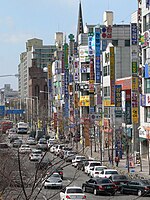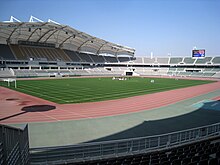Goyang
고양시 | |
|---|---|
| Korean transcription(s) | |
| • Hangul | 고양시 |
| • Hanja | 高陽市 |
| • Revised Romanization | Goyang-si |
| • McCune-Reischauer | Koyang-si |
 | |
 Location in South Korea | |
| Country | |
| Province | Gyeonggi |
| Region | Sudogwon |
| Administrative divisions | 3 gu, 39 dong |
| Government | |
| • Type | Mayor-Council |
| • Mayor | Lee Dong-hwan (People Power) |
| • Council | Goyang City Council |
| Area | |
| • Total | 286.1 km2 (110.5 sq mi) |
| Population (October, 2022) | |
| • Total | 1,074,784 |
| • Density | 3,800/km2 (9,700/sq mi) |
| • Dialect | Seoul |

Goyang (Goyang-si; Korean pronunciation: [ko.jaŋ]) is a city in Gyeonggi Province in the north of South Korea. It is part of the Seoul Capital Area, making Goyang one of Seoul's satellite cities. It is one of the largest cities in the Seoul Capital Area, with a population of just over 1 million. Ilsan, a planned city, is located in the Ilsandong-gu and Ilsanseo-gu districts of Goyang. It also includes Deogyang-gu which is closer to Seoul.
Several institutions of higher learning are located in Goyang. These include Agricultural Cooperative College, Korea Aerospace University, and Transnational Law and Business University.
Historic remains
Exhibitions
Entertainment and shopping
Leisure
On New Year's Day each year, a splendid festival is thrown at Haengju Sanseong to welcome the New Year's Day sunrise.
Time: 5:00-9:00 AM on New Year's Day each year Place: The top of the mountain where Haengju Sanseong sits.
The event is held to commemorate an important victory in Korean history (14 March) at Haengju Sanseong. Elementary school kids and their parents from the neighborhood can watch memorial services for patriotic martyrs of the nation and learn about the history of Haengju Sanseong.
Time: 10 AM on 14 March each year Place: Chungjang Shrine at Haengju Sanseoeng
Floricultural industry sprang up in the early 1970s fostering flower culture in Korea. Goyang became one of the most famous cities for its floricultural industry and its flower show grew into a horticultural event representing Korea and a venue for trading among participants at home and from abroad.
-Time: early April each year -Place: Areas surrounding Ilsan Lake Park
The event is free-style arts festival held at various locations around the Lake Park. Imagination and wits of artists getting out of the constraints imposed by stages fill the streets with vigor and romantic mood. Various performing arts including jazz, mime, dance, drama and installation arts decking out the venue with colorful decorations to add glamour, passionate performance by famous theatrical companies from around the world and fancy fireworks all let the cheerful spectators enjoy the excitement thrown by the festival.
Time: October each year Place: locations around the Lake Park
Ilsan New Town vaguely comes to mind, but in reality, the eastern boundary is Bukhansan, the western boundary is the Han River, and the city area itself is large and has various geographical features. However, Bukhansan is a region protruding to the east, and the eastern end of the border with Seoul is actually a hilly area connecting Mt. Aengbong and Mt. Bongsan. Across the Han River to the west is the city of Gimpo.
At the time of the expansion of Seoul, the eastern area was given to Seoul, but Bukhansan was guided, so if you look closely at the administrative divisions on the map, it looks like a kitchen knife or a stake. Bukhansan Mountain is clearly visible from the vicinity of Jichuk, and surprisingly, if you drive along the freeway from the middle floor of an apartment building in Ilsan New Town [10] or even from the side of Isanpo, you can see Bukhansan Mountain in the distance. You can roughly estimate the weather on that day by whether you can see it well or not.
Goyang has a monsoon-influenced humid continental climate (Köppen: Dwa) with cold, dry winters and hot, rainy summers.
| Climate data for Goyang (1993–2020 normals) | |||||||||||||
|---|---|---|---|---|---|---|---|---|---|---|---|---|---|
| Month | Jan | Feb | Mar | Apr | May | Jun | Jul | Aug | Sep | Oct | Nov | Dec | Year |
| Mean daily maximum °C (°F) | 2.2 (36.0) |
5.6 (42.1) |
11.7 (53.1) |
18.6 (65.5) |
24.5 (76.1) |
28.6 (83.5) |
29.7 (85.5) |
30.9 (87.6) |
27.0 (80.6) |
20.8 (69.4) |
12.3 (54.1) |
4.1 (39.4) |
18.0 (64.4) |
| Daily mean °C (°F) | −3.5 (25.7) |
−0.4 (31.3) |
5.2 (41.4) |
11.8 (53.2) |
17.4 (63.3) |
22.0 (71.6) |
24.8 (76.6) |
25.4 (77.7) |
20.8 (69.4) |
13.8 (56.8) |
6.3 (43.3) |
−1.2 (29.8) |
11.9 (53.4) |
| Mean daily minimum °C (°F) | −8.8 (16.2) |
−6.0 (21.2) |
−0.6 (30.9) |
5.5 (41.9) |
11.3 (52.3) |
16.7 (62.1) |
21.3 (70.3) |
21.5 (70.7) |
15.6 (60.1) |
7.8 (46.0) |
1.0 (33.8) |
−6.4 (20.5) |
6.6 (43.9) |
| Average precipitation mm (inches) | 10.9 (0.43) |
20.2 (0.80) |
23.5 (0.93) |
58.6 (2.31) |
87.3 (3.44) |
107.7 (4.24) |
359.3 (14.15) |
274.1 (10.79) |
117.1 (4.61) |
44.9 (1.77) |
38.9 (1.53) |
13.9 (0.55) |
1,156.4 (45.53) |
| Average precipitation days (≥ 0.1 mm) | 2.5 | 2.8 | 4.1 | 6.6 | 7.2 | 7.6 | 12.9 | 11.2 | 6.5 | 5.0 | 6.3 | 3.9 | 76.6 |
| Source: Korea Meteorological Administration[1] | |||||||||||||

The ice hockey team High1, based in Chuncheon, played some of its home Asia League Ice Hockey matches at the Goyang Ice Rink, before they withdrew from the league in 2019.[2]
Former football teams in Goyang include Goyang KB Kookmin Bank FC and Goyang Zaicro FC. Currently, there is the K4 League team Goyang Citizen FC.
The Korean Basketball League team Goyang Sono Skygunners is also based in the city.[3]
Goyang used to be served by a bike sharing system called Fifteen (KR:피프틴), which was replaced by a new system Tajo (KR:타조).[4]
Subway
Commuter Rail
High Speed Railways
Bus stops on Goyang Bus Rapid Transit (BRT)
Types of buses
and districts.
Bus Terminals
|
See also: List of twin towns and sister cities in South Korea |